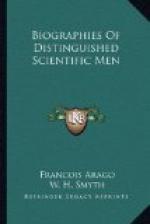When he has scarcely escaped from this physical and moral torture, and the astronomer wishes to know what degree of utility is deducible from his labours, he is obliged to plunge into numerical calculations of repelling length and intricacy. Some observations that have been made in less than a minute, require a whole day’s work in order to be compared with the tables.
Such was the view that Lacaille, without any softening, exhibited to his young friend; such was the profession into which the adolescent poet plunged with great ardour, and without having been at all prepared for the transition.
A useful calculation constituted the first claim of our tyro to the attention of the learned world.
The year 1759 had been marked by one of those great events, the memory of which is religiously preserved in scientific history. A comet, that of 1682, had returned at the epoch foretold by Clairaut, and very nearly in the region that mathematical analysis had indicated to him. This reappearance raised comets out of the category of sublunary meteors; it gave them definitely closed curves as orbits, instead of parabolas, or even mere straight lines; attraction confined them within its immense domain; in short, these bodies ceased for ever to be liable to superstition regarding them as prognostics.
The stringency, the importance of these results, would naturally increase in proportion as the resemblance between the announced orbit and the real orbit became more evident.
This was the motive that determined so many astronomers to calculate the orbit of the comet minutely, from the observations made in 1759, throughout Europe. Bailly was one of those zealous calculators. In the present day, such a labour would scarcely deserve special mention; but we must remark that the methods at the close of the eighteenth century were far from being so perfect as those that are now in use, and that they greatly depended on the personal ability of the individual who undertook them.




